Code
HCS29511
Weight
200 gm / 0.44 lbs
Size
Height
61cm (24") Width
45cm (18") Material
Cotton Canvas & Natural Color
Availability
Available

Safe Payment
We accept Paypal, Money Transfer, Bank Transfer
Confidence
Protection covers your purchase and personal data.
Worldwide Delivery
We ship Worldwide, except Russia.Shipping cost US$25.2 for upto 0.5 kgs

Hotline
Talk to help line for your question on 9841267335Karma Gadri Art : Karma Gadri Tradition: An introduction
Description inspired from Images of Englitment.
This Custom of Tibetan thangka painting started from the creative ordered trials of the eighth Karmapa, Mikyö Dorje (1507-1554). He was one of the most prestigious Karmapas, a great contemplation ace as well as a productive, and student. Energetic about human expression and an imaginative visionary. He generally urged his devotees to master painting and cheered for this action.
The name Karma Gadri (gar-bris) came from the Karmapa settlements
It was set up when Mikyo Dorje and his company needed to travel. He composed an incredible book on craftsmanship named "the Incomparable Sun Workmanship Manual". It was beneficial for future craftsmen.
This thangka painting custom was likewise kept up within a spot called Karshoma, in eastern Tibet. To this end, the custom is known as Karshöma.
Since the source is from the eighth Karmapa, it is an unadulterated Tibetan way of painting thangka.
Description inspired from Images of Englitment.
This Custom of Tibetan thangka painting started from the creative ordered trials of the eighth Karmapa, Mikyö Dorje (1507-1554). He was one of the most prestigious Karmapas, a great contemplation ace as well as a productive, and student. Energetic about human expression and an imaginative visionary. He generally urged his devotees to master painting and cheered for this action.
The name Karma Gadri (gar-bris) came from the Karmapa settlements
It was set up when Mikyo Dorje and his company needed to travel. He composed an incredible book on craftsmanship named "the Incomparable Sun Workmanship Manual". It was beneficial for future craftsmen.
This thangka painting custom was likewise kept up within a spot called Karshoma, in eastern Tibet. To this end, the custom is known as Karshöma.
Since the source is from the eighth Karmapa, it is an unadulterated Tibetan way of painting thangka.
Introduction to Thangka
A thangka, also known as tangka, thanka, or tanka, is a vibrant and intricate Tibetan Buddhist painting that serves as a visual representation of spiritual teachings. Crafted with meticulous detail on cotton or silk appliqué, thangkas depict a wide range of subjects including Buddhist deities, sacred scenes, mandalas, and narrative stories. These sacred artworks are traditionally kept unframed and rolled up for storage, resembling ancient scrolls. To protect their delicate nature, thangkas are mounted on textile backings and often adorned with a silk cover on the front. Proper preservation in dry environments is crucial to maintain the integrity and longevity of the silk. Read More . . .
A thangka, also known as tangka, thanka, or tanka, is a vibrant and intricate Tibetan Buddhist painting that serves as a visual representation of spiritual teachings. Crafted with meticulous detail on cotton or silk appliqué, thangkas depict a wide range of subjects including Buddhist deities, sacred scenes, mandalas, and narrative stories. These sacred artworks are traditionally kept unframed and rolled up for storage, resembling ancient scrolls. To protect their delicate nature, thangkas are mounted on textile backings and often adorned with a silk cover on the front. Proper preservation in dry environments is crucial to maintain the integrity and longevity of the silk. Read More . . .
Brief Introduction :
Tsongkhapa usually taken to mean "the Man from Onion Valley", born in Amdo, was a famous teacher of Tibetan Buddhism whose activities led to the formation of the Gelug school of Tibetan Buddhism. He is also known by his ordained name Losang Drakpa (Wylie: blo bzang grags pa) or simply as "Je Rinpoche" (Wylie: rje rin po che). Also, he is known by the Chinese as Zongkapa Lobsang Zhaba, He was the son of a Tibetan Longben Tribal leader who also once served as an official of the Yuan Dynasty of China.
In his two main treatises, the Lamrim Chenmo (Wylie: lam rim chen mo) and Ngakrim Chenmo (Wylie: sngags rim chen mo), Tsongkhapa meticulously sets forth this graduated way and how one establishes oneself in the paths of sutra and tantra.
Life History :In his two main treatises, the Lamrim Chenmo (Wylie: lam rim chen mo) and Ngakrim Chenmo (Wylie: sngags rim chen mo), Tsongkhapa meticulously sets forth this graduated way and how one establishes oneself in the paths of sutra and tantra.
<strong>Early Life</strong>
With a Mongolian father and a Tibetan mother, Tsongkhapa was born into a nomadic family in the walled city of Tsongkhapa in Amdo, Tibet (present-day Haidong and Xining, Qinghai) in 1357. It is said that the Buddha Sakyamuni spoke of his coming as an emanation of the Bodhisattva Manjusri in the short verse from the Root Tantra of Manjushri (Wylie: 'jam dpal rtsa rgyud):
After I pass away
And my pure doctrine is absent,
You will appear as an ordinary being,
Performing the deeds of a Buddha
And establishing the Joyful Land, the great Protector,
In the Land of the Snows.
According to hagiographic accounts, Tsongkhapa's birth was prophesied by the 12th abbot of the Snar thang monastery and was recognized as such at a young age, taking the lay vows at the age of three before Rolpe Dorje, 4th Karmapa Lama, and was named Künga Nyingpo (Wylie: kun dga' snying po). At the age of seven, he was ordained as a ?r?ma?era by Döndrup Rinchen (Wylie: don grub rin chen, 1309â1385), the first abbott of Jakhyung Monastery (Wylie: bya khyung brag), and was given the ordination name Losang Drakpa (Wylie: blo bzang grags pa).
<strong>Monastic career</strong>
It was at this early age that he was able to receive the empowerments of Heruka, Hevajra, and Yamantaka, three of the most prominent wrathful deities of Tibetan Buddhism, as well as being able to recite a great many Sutras, not the least of which was Mañju?r?n?masamg?ti. He would go on to be a great student of the Vinaya, the doctrine of behavior, and even later of the Six Yogas of Naropa, the Kalachakra tantra, and the practice of Mahamudra. At the age of 24, he received full ordination as a monk of the Sakya school.
From Zhönnu Lodrö (Wylie: gzhon nu blo gros) and Rendawa (Wylie: red mda' pa), he received the lineage of the Pramanavarttika transmitted by Sakya Pandita. He mastered all the courses of study at Drigung kagyud Monastery in Ã-Tsang.
As an emanation of Manjusri, Tsongkhapa is said to have been of "one mind" with Ati?a, received the Kadam lineages and studied the major Sarma tantras under Sakya and Kagyu masters. He also studied with a Nyingma teacher, the siddha Lek gyi Dorjé (Wylie: legs gyi rdo rje) and the abbot of Shalu Monastery, Chö kyi Pel (Wylie: zhwa lus pa chos kyi dpal), and his main Dzogchen master was Drupchen Lekyi Dorje (Wylie: grub chen las kyi rdo je), also known as Namkha Gyaltsen (Wylie: nam mkha' rgyal mtshan, 1326â1401).
In addition to his studies, he engaged in extensive meditation retreats. He is reputed to have performed millions of prostrations, mandala offerings, and other forms of purification practice. Tsongkhapa often had visions of i??adevat?s, especially of Manjusri, with whom he would communicate directly to clarify difficult points of the scriptures.
<strong>Monastic career</strong>
It was at this early age that he was able to receive the empowerments of Heruka, Hevajra, and Yamantaka, three of the most prominent wrathful deities of Tibetan Buddhism, as well as being able to recite a great many Sutras, not the least of which was Mañju?r?n?masamg?ti. He would go on to be a great student of the vinaya, the doctrine of behaviour, and even later of the Six Yogas of Naropa, the Kalachakra tantra, and the practice of Mahamudra. At the age of 24, he received full ordination as a monk of the Sakya school.
From Zhönnu Lodrö (Wylie: gzhon nu blo gros) and Rendawa (Wylie: red mda' pa), he received the lineage of the Pramanavarttika transmitted by Sakya Pandita. He mastered all the courses of study at Drigung kagyud Monastery in Ã-Tsang.
As an emanation of Manjusri, Tsongkhapa is said have been of "one mind" with Ati?a, received the Kadam lineages and studied the major Sarma tantras under Sakya and Kagyu masters. He also studied with a Nyingma teacher, the siddha Lek gyi Dorjé (Wylie: legs gyi rdo rje) and the abbot of Shalu Monastery, Chö kyi Pel (Wylie: zhwa lus pa chos kyi dpal), and his main Dzogchen master was Drupchen Lekyi Dorje (Wylie: grub chen las kyi rdo je), also known as Namkha Gyaltsen (Wylie: nam mkha' rgyal mtshan, 1326â1401).
In addition to his studies, he engaged in extensive meditation retreats. He is reputed to have performed millions of prostrations, mandala offerings and other forms of purification practice. Tsongkhapa often had visions of i??adevat?s, especially of Manjusri, with whom he would communicate directly to clarify difficult points of the scriptures.
<strong>Death</strong>
Tsongkhapa died in 1419 at the age of sixty-two. After his death several biographies were written by Lamas of different traditions. Wangchuk Dorje, 9th Karmapa Lama, praised Tsongkhapa as one "who swept away wrong views with the correct and perfect ones." Mikyö Dorje, 8th Karmapa Lama, wrote in his poem In Praise of the Incomparable Tsong Khapa:
When the teachings of the Sakya, Kagyue, Kadam
And Nyingma sects in Tibet were declining,
You, O Tsong Khapa, revived Buddha's Doctrine,
Hence I sing this praise to you of Ganden Mountain.
With a Mongolian father and a Tibetan mother, Tsongkhapa was born into a nomadic family in the walled city of Tsongkhapa in Amdo, Tibet (present-day Haidong and Xining, Qinghai) in 1357. It is said that the Buddha Sakyamuni spoke of his coming as an emanation of the Bodhisattva Manjusri in the short verse from the Root Tantra of Manjushri (Wylie: 'jam dpal rtsa rgyud):
After I pass away
And my pure doctrine is absent,
You will appear as an ordinary being,
Performing the deeds of a Buddha
And establishing the Joyful Land, the great Protector,
In the Land of the Snows.
According to hagiographic accounts, Tsongkhapa's birth was prophesied by the 12th abbot of the Snar thang monastery and was recognized as such at a young age, taking the lay vows at the age of three before Rolpe Dorje, 4th Karmapa Lama, and was named Künga Nyingpo (Wylie: kun dga' snying po). At the age of seven, he was ordained as a ?r?ma?era by Döndrup Rinchen (Wylie: don grub rin chen, 1309â1385), the first abbott of Jakhyung Monastery (Wylie: bya khyung brag), and was given the ordination name Losang Drakpa (Wylie: blo bzang grags pa).
<strong>Monastic career</strong>
It was at this early age that he was able to receive the empowerments of Heruka, Hevajra, and Yamantaka, three of the most prominent wrathful deities of Tibetan Buddhism, as well as being able to recite a great many Sutras, not the least of which was Mañju?r?n?masamg?ti. He would go on to be a great student of the Vinaya, the doctrine of behavior, and even later of the Six Yogas of Naropa, the Kalachakra tantra, and the practice of Mahamudra. At the age of 24, he received full ordination as a monk of the Sakya school.
From Zhönnu Lodrö (Wylie: gzhon nu blo gros) and Rendawa (Wylie: red mda' pa), he received the lineage of the Pramanavarttika transmitted by Sakya Pandita. He mastered all the courses of study at Drigung kagyud Monastery in Ã-Tsang.
As an emanation of Manjusri, Tsongkhapa is said to have been of "one mind" with Ati?a, received the Kadam lineages and studied the major Sarma tantras under Sakya and Kagyu masters. He also studied with a Nyingma teacher, the siddha Lek gyi Dorjé (Wylie: legs gyi rdo rje) and the abbot of Shalu Monastery, Chö kyi Pel (Wylie: zhwa lus pa chos kyi dpal), and his main Dzogchen master was Drupchen Lekyi Dorje (Wylie: grub chen las kyi rdo je), also known as Namkha Gyaltsen (Wylie: nam mkha' rgyal mtshan, 1326â1401).
In addition to his studies, he engaged in extensive meditation retreats. He is reputed to have performed millions of prostrations, mandala offerings, and other forms of purification practice. Tsongkhapa often had visions of i??adevat?s, especially of Manjusri, with whom he would communicate directly to clarify difficult points of the scriptures.
<strong>Monastic career</strong>
It was at this early age that he was able to receive the empowerments of Heruka, Hevajra, and Yamantaka, three of the most prominent wrathful deities of Tibetan Buddhism, as well as being able to recite a great many Sutras, not the least of which was Mañju?r?n?masamg?ti. He would go on to be a great student of the vinaya, the doctrine of behaviour, and even later of the Six Yogas of Naropa, the Kalachakra tantra, and the practice of Mahamudra. At the age of 24, he received full ordination as a monk of the Sakya school.
From Zhönnu Lodrö (Wylie: gzhon nu blo gros) and Rendawa (Wylie: red mda' pa), he received the lineage of the Pramanavarttika transmitted by Sakya Pandita. He mastered all the courses of study at Drigung kagyud Monastery in Ã-Tsang.
As an emanation of Manjusri, Tsongkhapa is said have been of "one mind" with Ati?a, received the Kadam lineages and studied the major Sarma tantras under Sakya and Kagyu masters. He also studied with a Nyingma teacher, the siddha Lek gyi Dorjé (Wylie: legs gyi rdo rje) and the abbot of Shalu Monastery, Chö kyi Pel (Wylie: zhwa lus pa chos kyi dpal), and his main Dzogchen master was Drupchen Lekyi Dorje (Wylie: grub chen las kyi rdo je), also known as Namkha Gyaltsen (Wylie: nam mkha' rgyal mtshan, 1326â1401).
In addition to his studies, he engaged in extensive meditation retreats. He is reputed to have performed millions of prostrations, mandala offerings and other forms of purification practice. Tsongkhapa often had visions of i??adevat?s, especially of Manjusri, with whom he would communicate directly to clarify difficult points of the scriptures.
<strong>Death</strong>
Tsongkhapa died in 1419 at the age of sixty-two. After his death several biographies were written by Lamas of different traditions. Wangchuk Dorje, 9th Karmapa Lama, praised Tsongkhapa as one "who swept away wrong views with the correct and perfect ones." Mikyö Dorje, 8th Karmapa Lama, wrote in his poem In Praise of the Incomparable Tsong Khapa:
When the teachings of the Sakya, Kagyue, Kadam
And Nyingma sects in Tibet were declining,
You, O Tsong Khapa, revived Buddha's Doctrine,
Hence I sing this praise to you of Ganden Mountain.


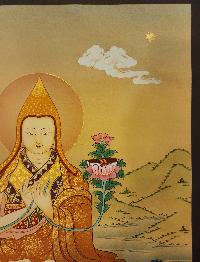
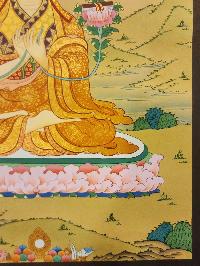



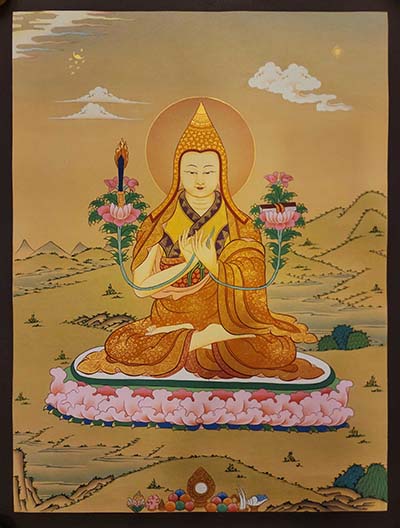
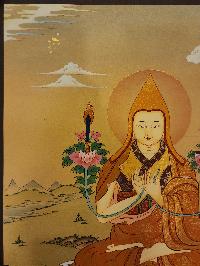










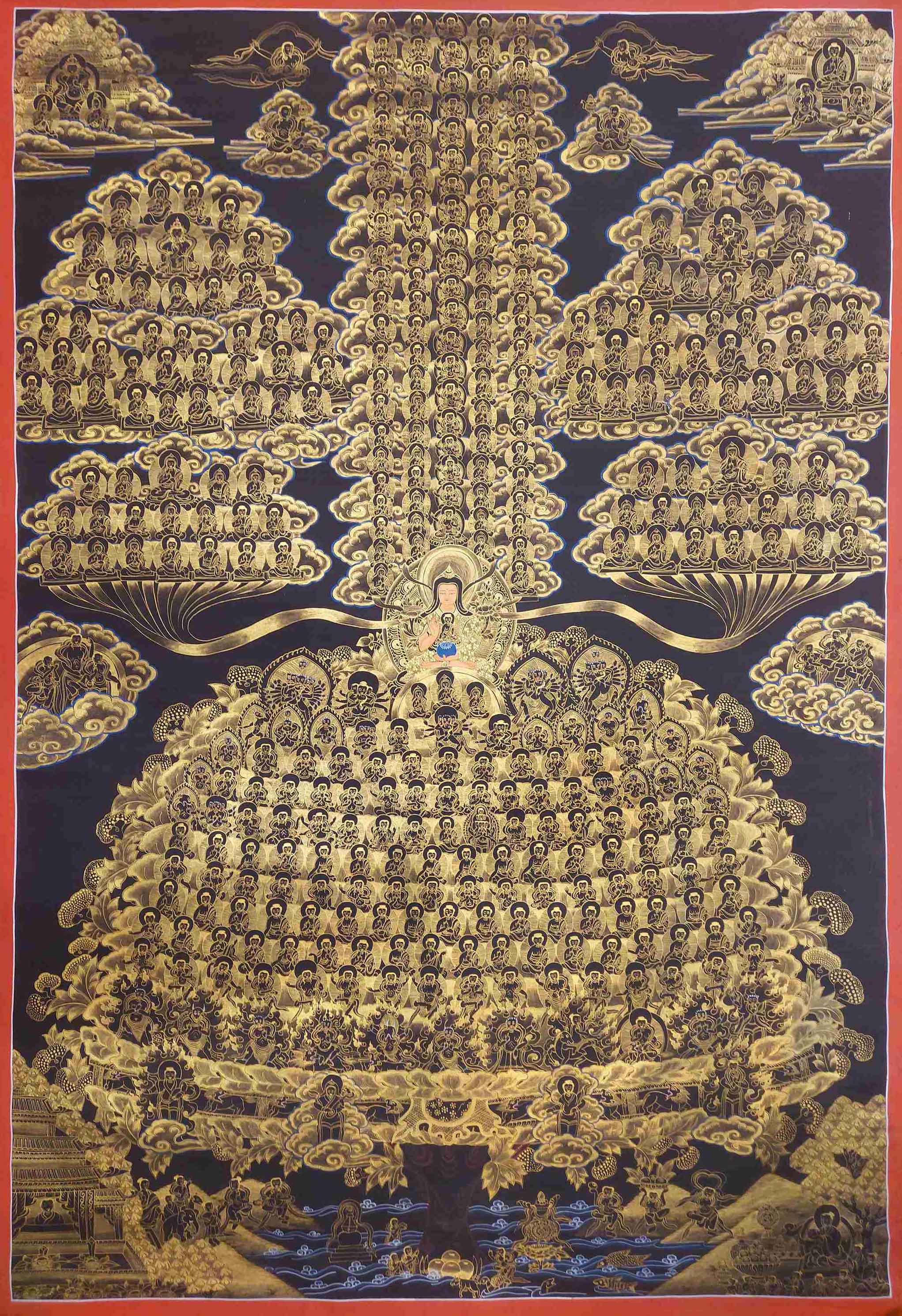 of
of 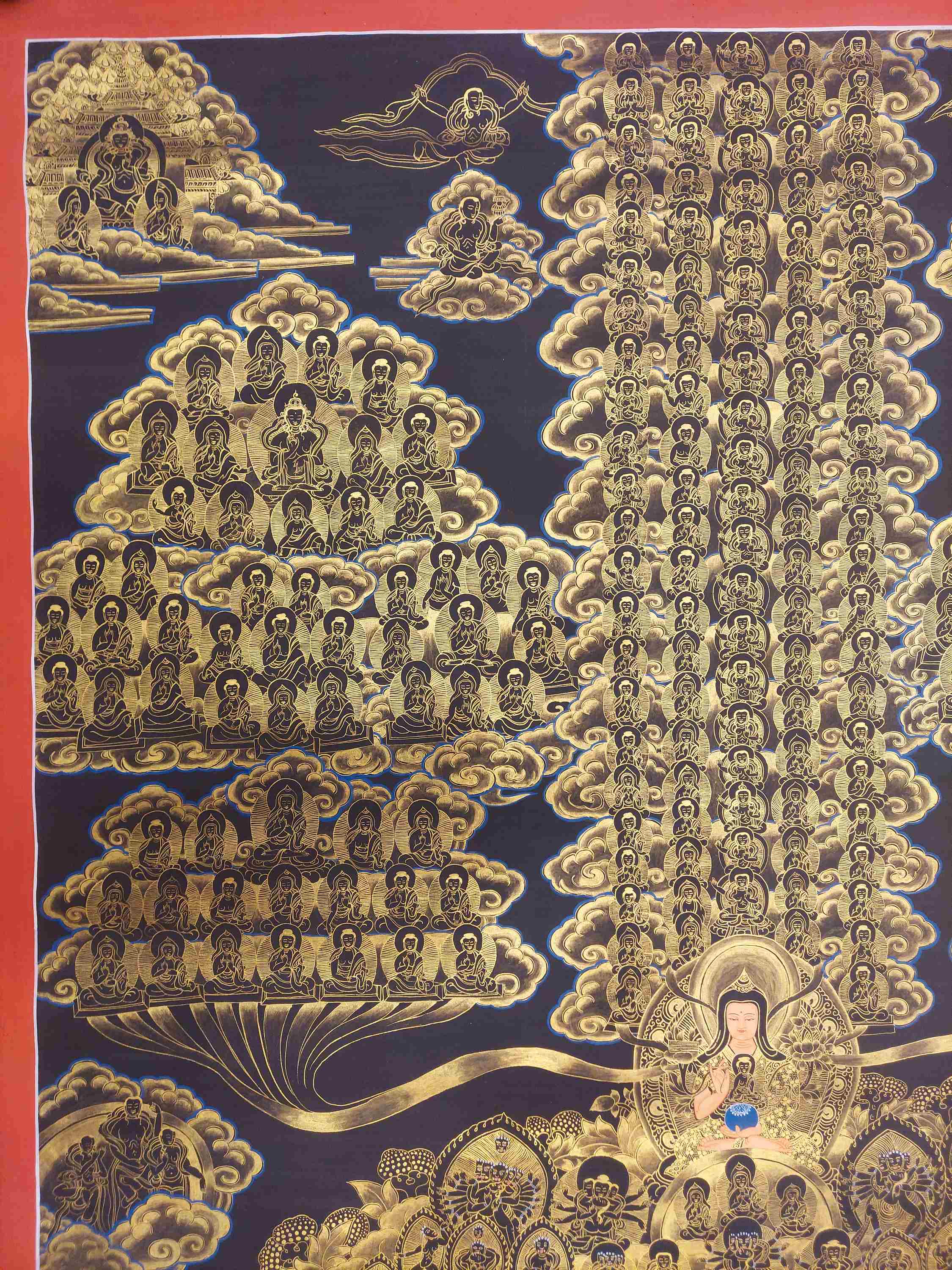 of
of 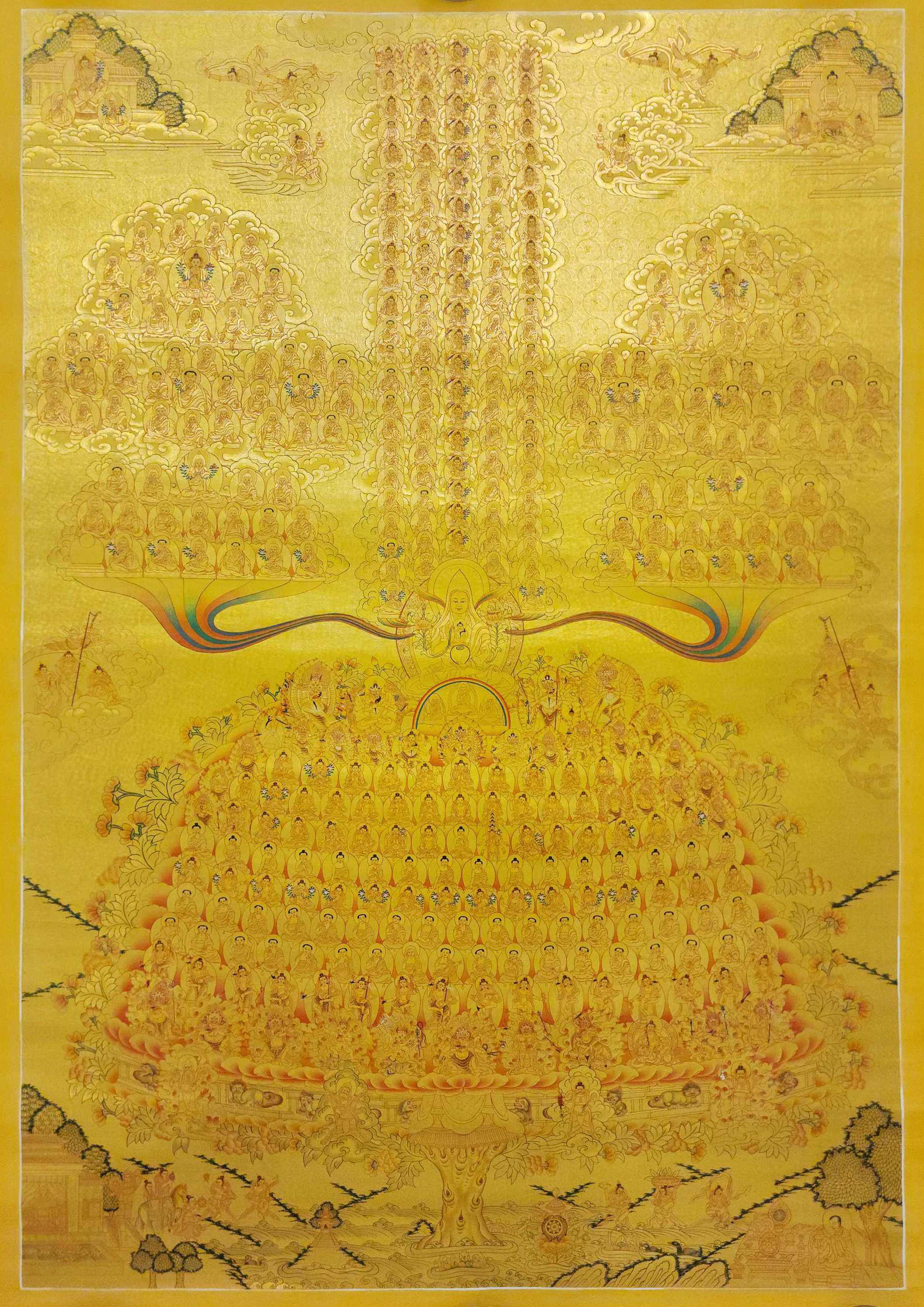 Master Quality, Buddhist Traditional Painting, Lhyape Style,
Master Quality, Buddhist Traditional Painting, Lhyape Style,  Master Quality, Buddhist Traditional Painting, Lhyape Style,
Master Quality, Buddhist Traditional Painting, Lhyape Style,  Real Gold,
Real Gold, 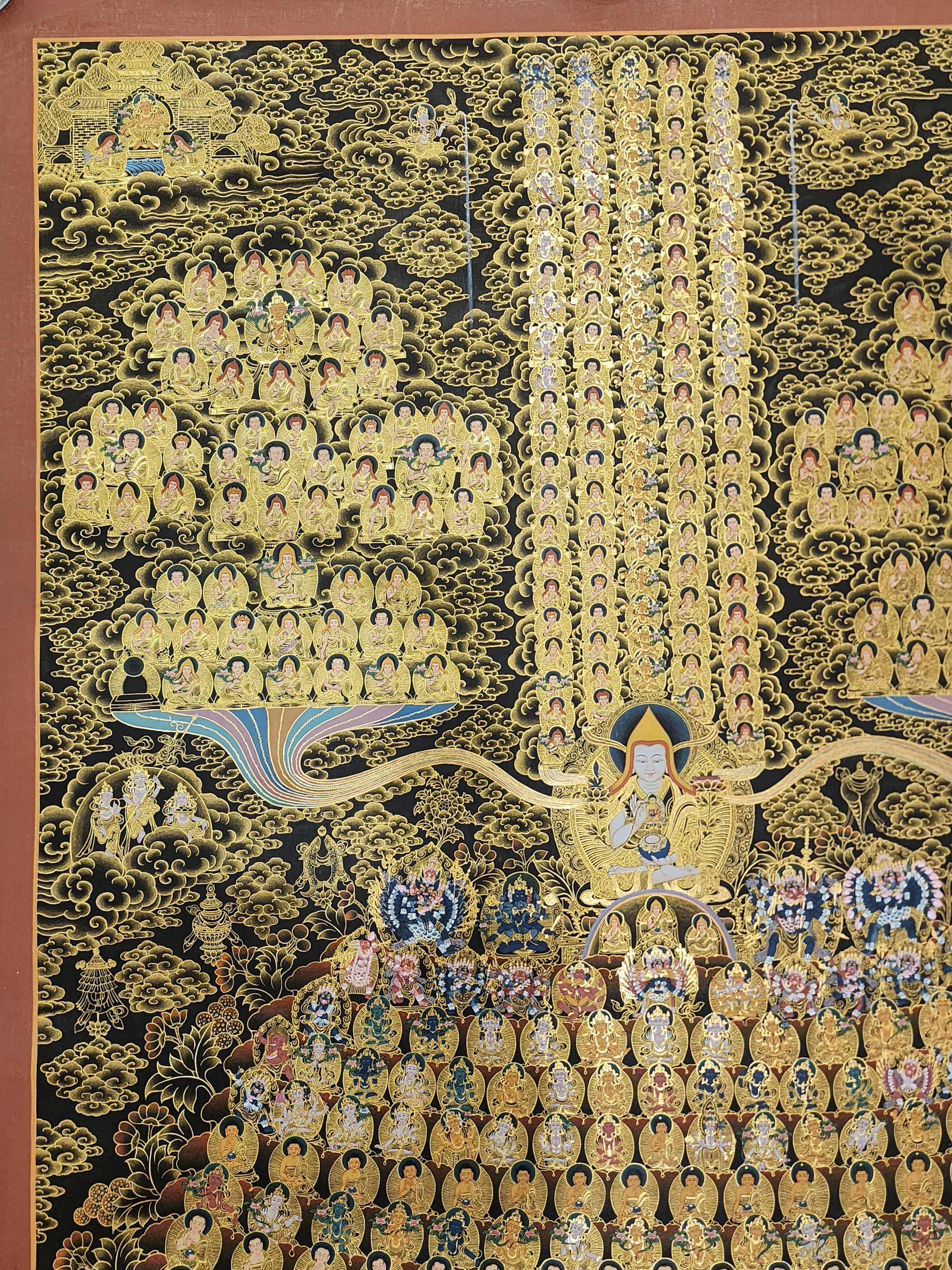 Real Gold,
Real Gold, 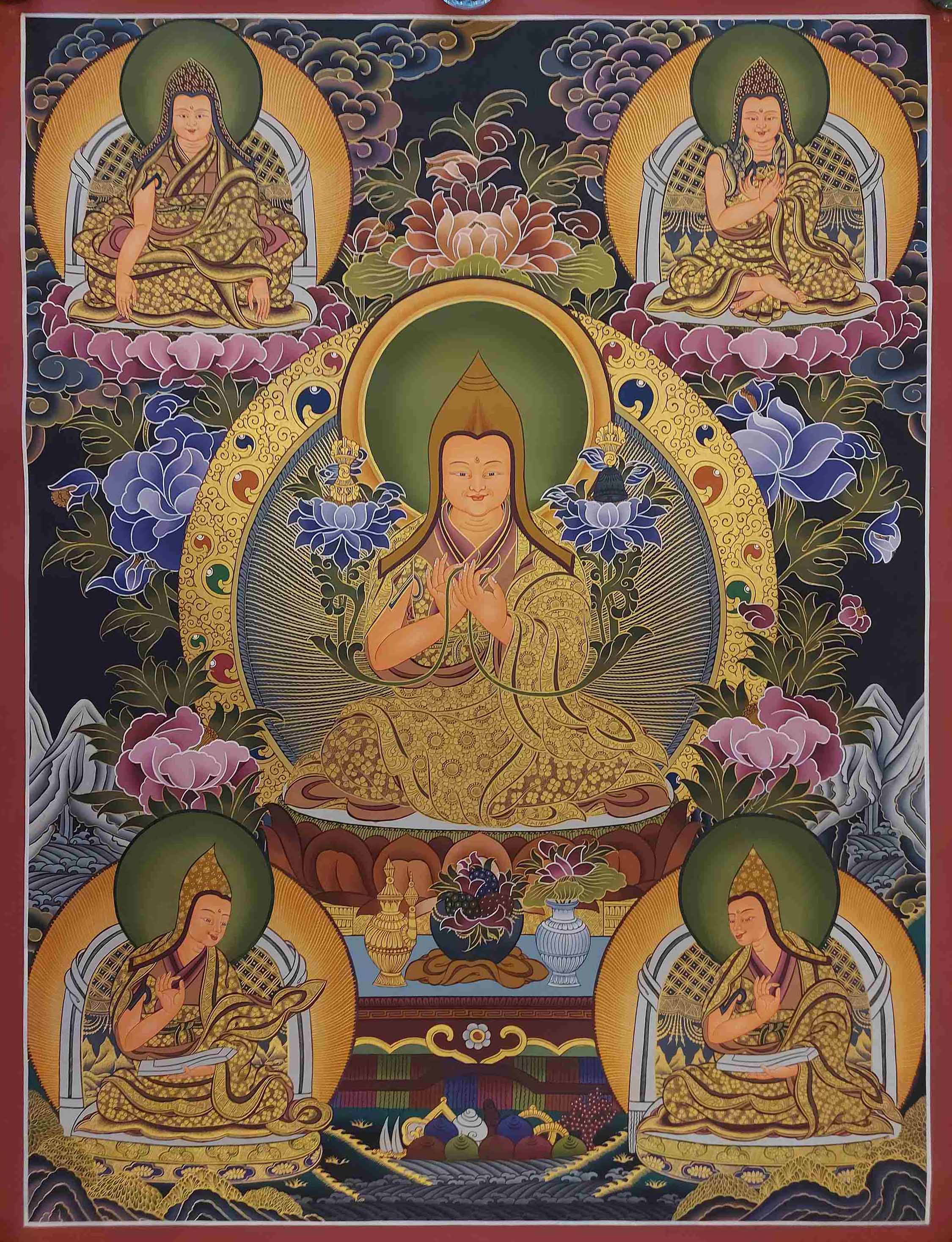 of Tsongkhapa,
of Tsongkhapa, 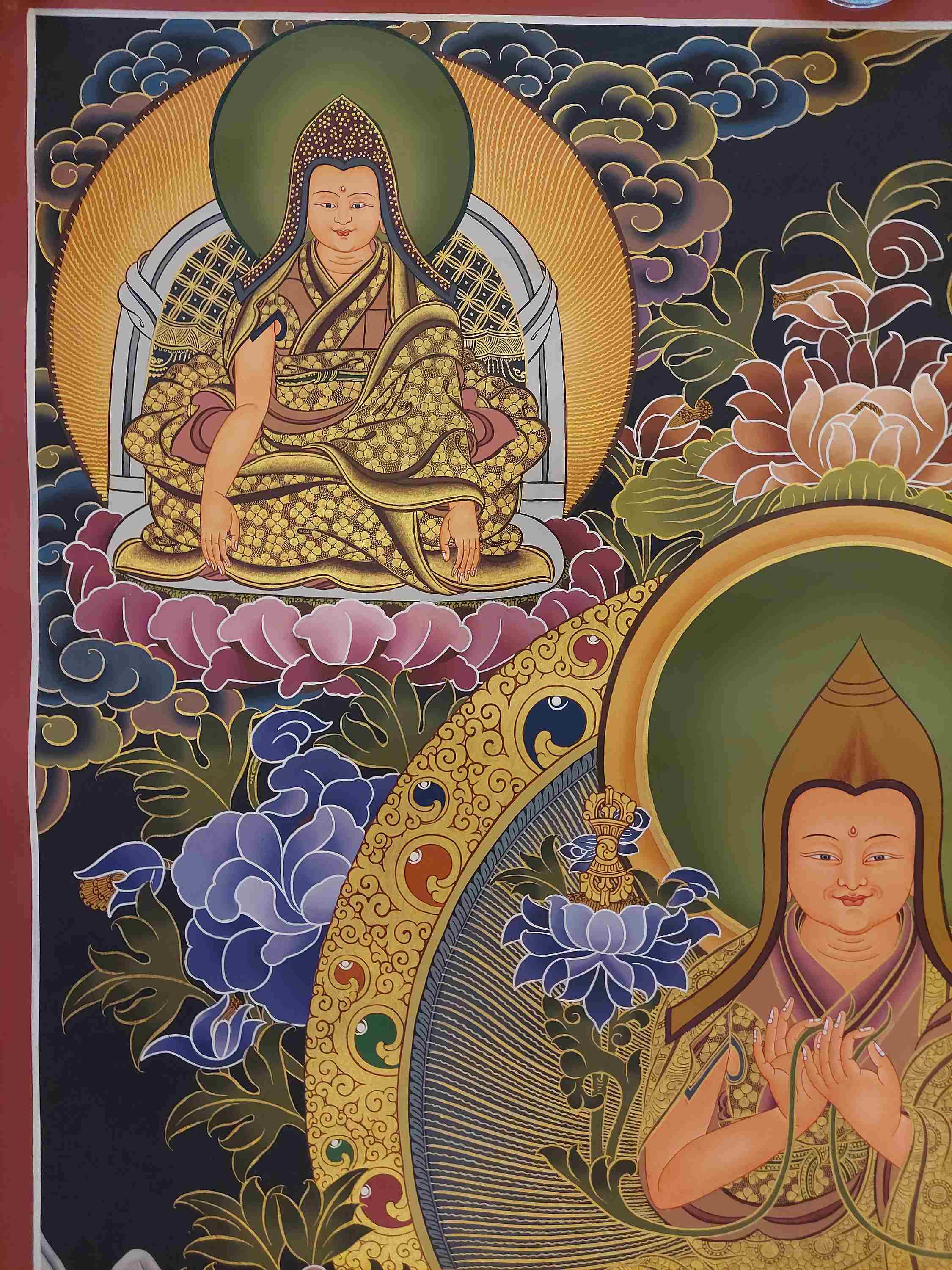 of Tsongkhapa,
of Tsongkhapa, 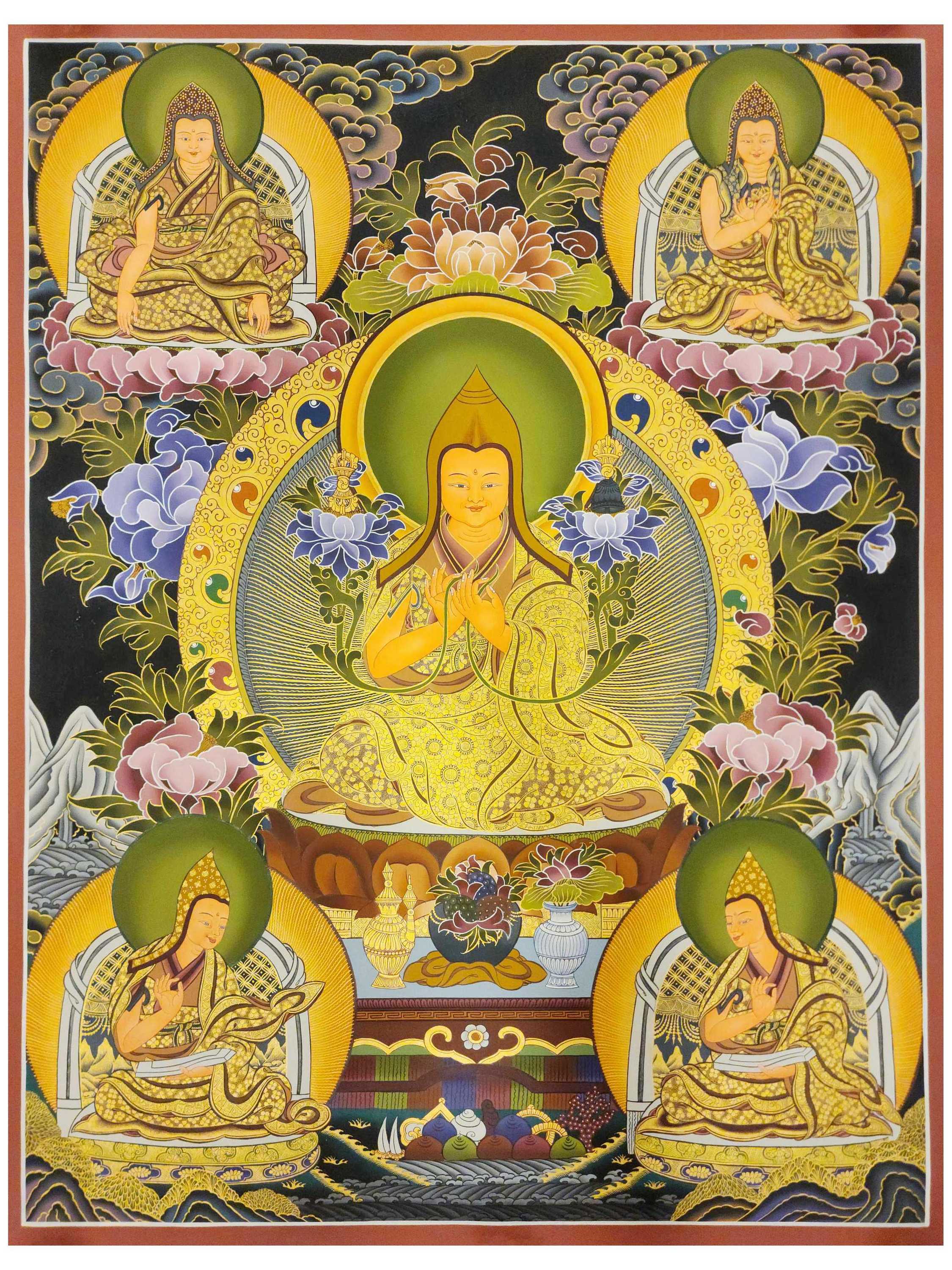
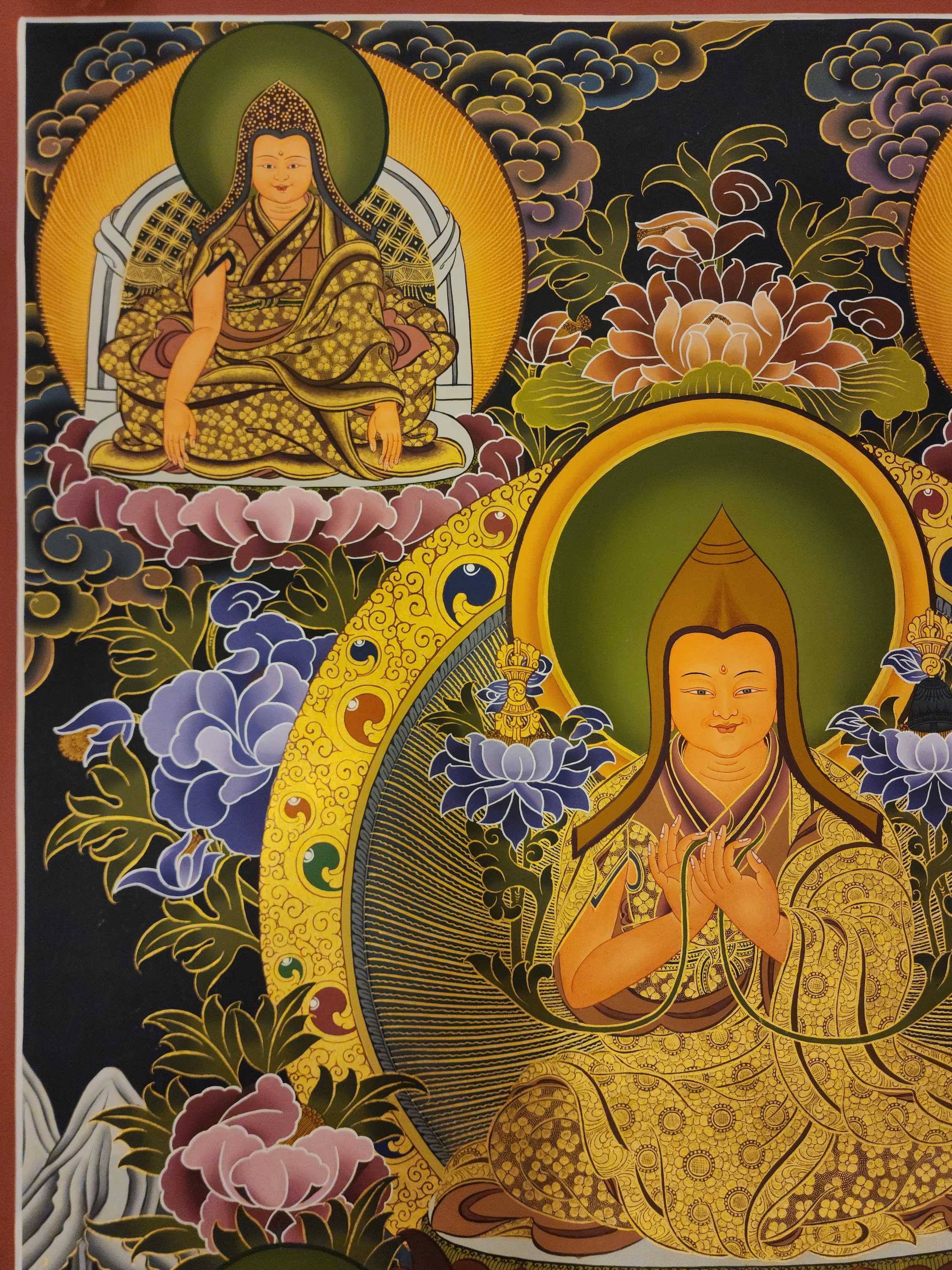
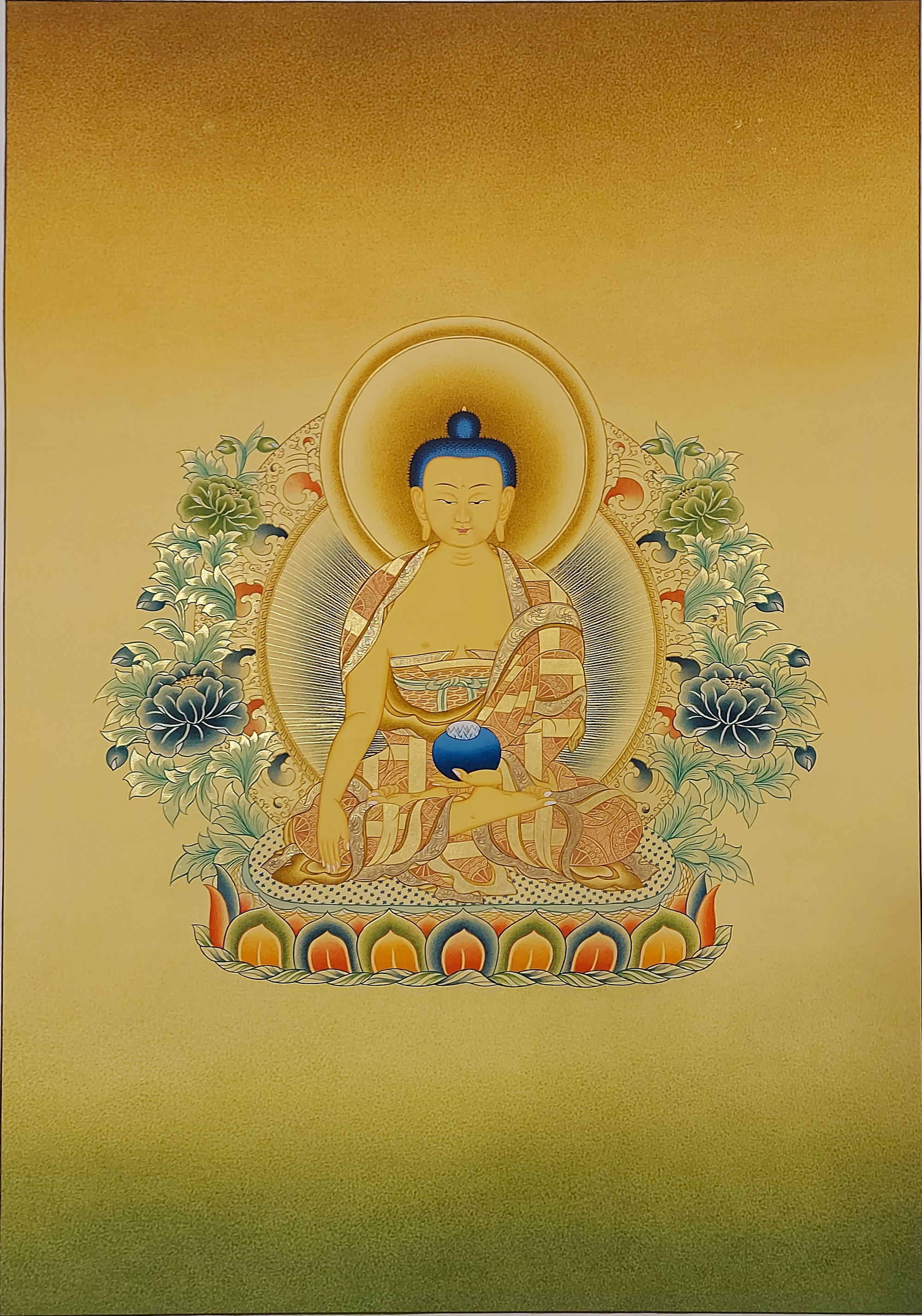 Karma Gadri Art, Handmade Thangka
Karma Gadri Art, Handmade Thangka 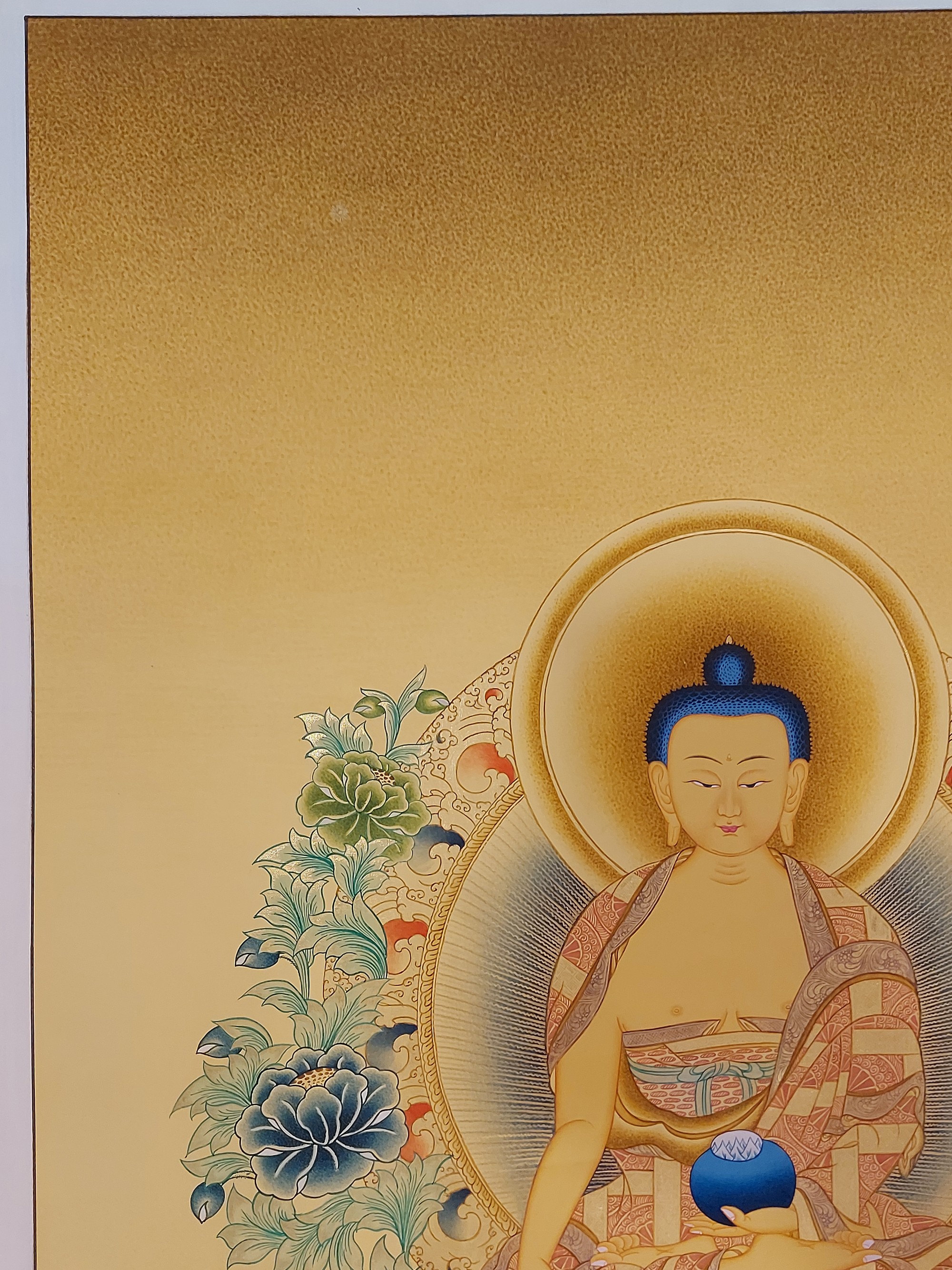 Karma Gadri Art, Handmade Thangka
Karma Gadri Art, Handmade Thangka  Karma Gadri Art Style, Buddhist Handmade Thangka
Karma Gadri Art Style, Buddhist Handmade Thangka 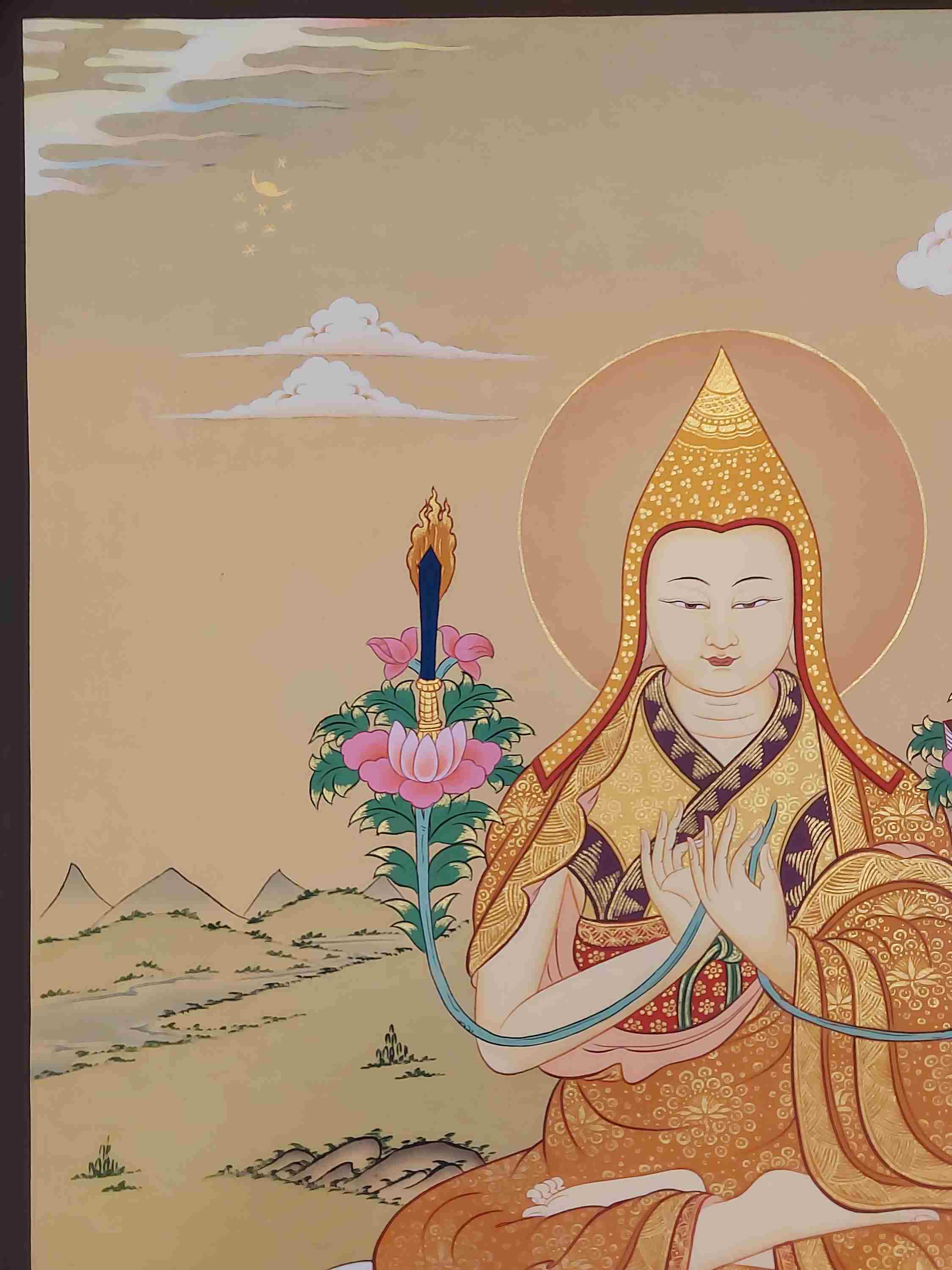 Karma Gadri Art Style, Buddhist Handmade Thangka
Karma Gadri Art Style, Buddhist Handmade Thangka